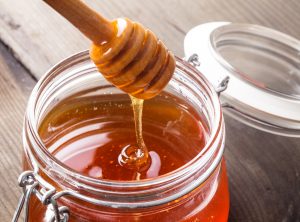By Heide Kennedy, Arizona Farm Bureau Communications Intern
Do you always keep a jar of raw honey sitting on your counter or in your pantry? If so, you’ve probably seen it change to a lighter color and get a grainy texture to it over time. This is called crystallization, and you might wonder how it happens and if it affects the quality of the honey. I took some time to quiz my little brother who owns his own beehives and raw honey business and get his opinion on the topic.

(photo credit: BigStockPhoto.com)
So, first up, why does it crystallize? Raw honey crystallizes because it’s a supersaturated sugar solution made up of water and the sugars glucose and fructose. After a while, the water begins to separate from the glucose, causing the honey to become crystallized. It’s important to note that it doesn’t mean that the honey is old, or that it has lost its quality. It’s just a natural process that happens to raw honey.
Some other factors that play a role in the crystallization of honey are the nectar source, as well as whether or not the honey is raw or processed. The nectar source of the honey influences the speed at which honey crystallizes as well as the texture of those crystals. Honey made from the nectar of mesquite tree flowers, like what my brother makes, is known for crystallizing exceptionally fast. Likewise, honey that is raw is more likely to crystallize than processed honey. This is because crystals like to form around things, and because it has been minimally processed, raw honey still contains some of the natural elements that are in honey, such as pollen.
Some people like their honey to be crystallized, as it isn’t as runny and can be spread a little easier. And then there are others who are not fans of having their honey crystallized. To make your honey runny again, simply heat it up gently in a pot of water that’s about 100-110 degrees F. It’s very important to not heat your honey any more than 100-110 degrees because then you run the risk of disrupting the pollen, enzymes, and other good stuff that is present in raw honey.
Well, I definitely learned a lot from my little brother about honey and its crystallization process, and I hope you did too! For some cool bee pictures, more information about raw honey, as well as a way to order some local, raw honey, check out his Facebook page!
For more articles on honey and bees, check out the Fill Your Plate blog!

